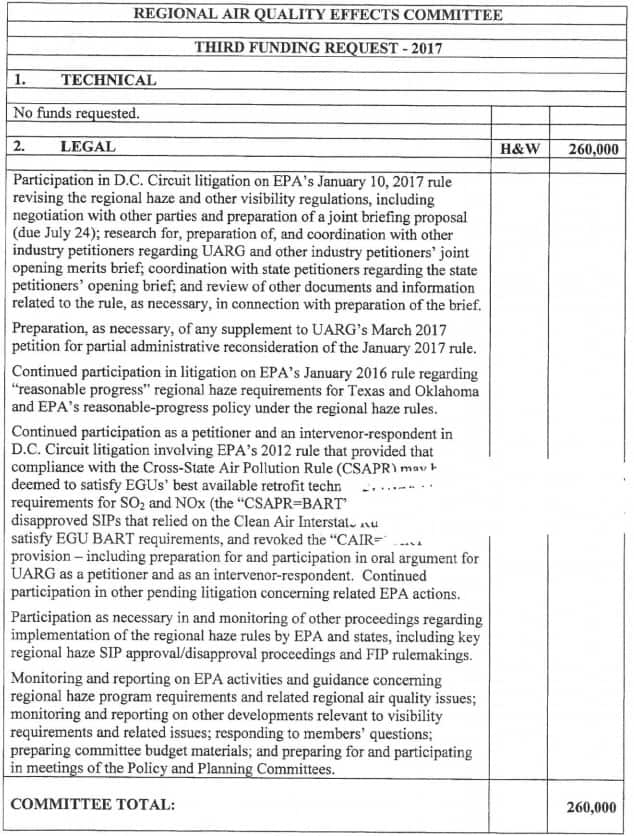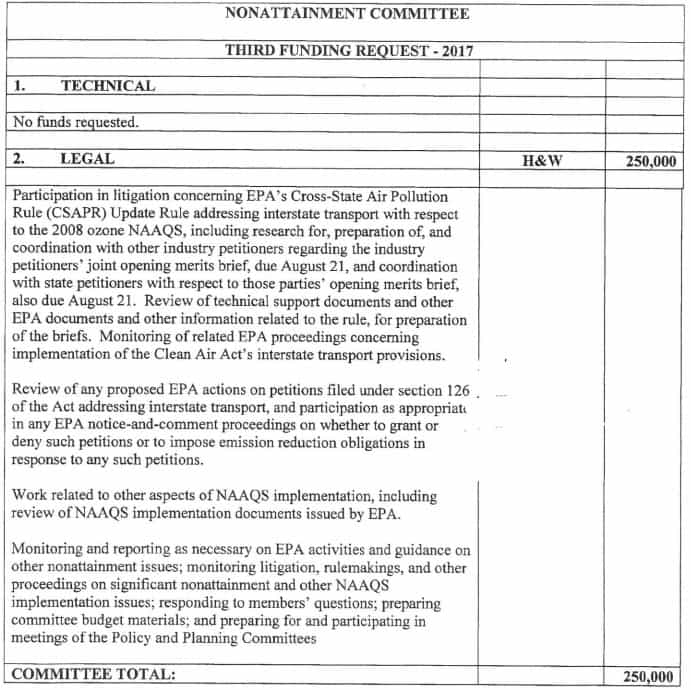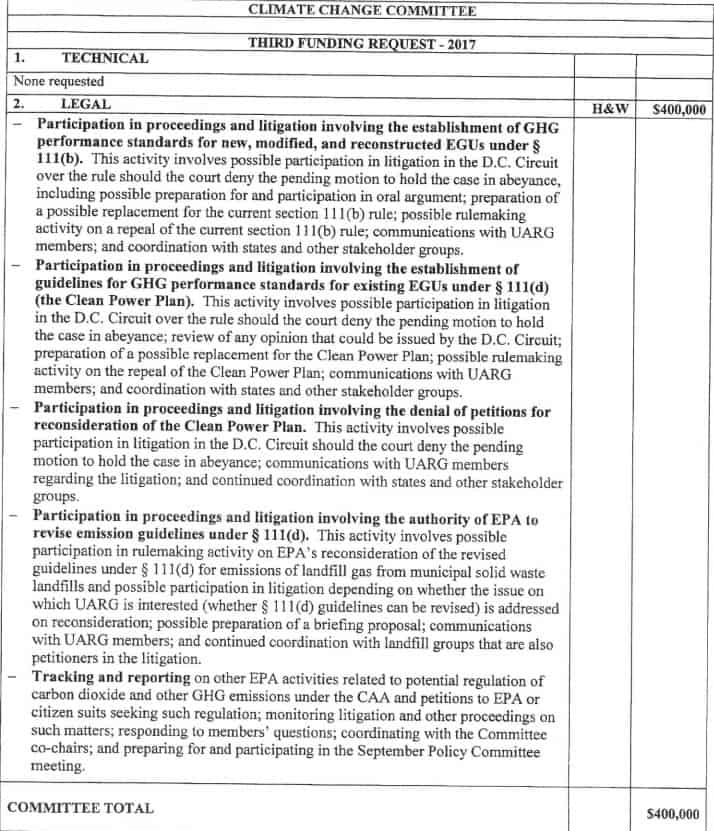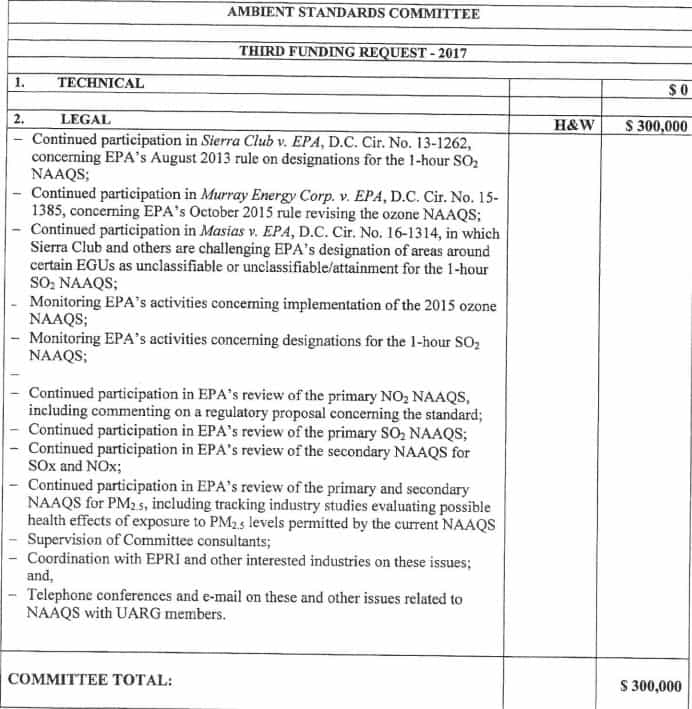As investigations continue into former Utility Air Regulatory Group attorney and EPA Assistant Administrator Bill Wehrum over possible violations of ethics rules, a flood of utility companies that were members of the UARG group have announced their departure.
The remaining utility members of UARG, which has fought against clean air standards for four decades, have come under increasing scrutiny, including having to answer questions about whether the companies have been forcing their customers to fund UARG on their monthly electric bills.
In response, the remaining UARG members have made misleading claims about the role that UARG plays, characterizing it as a technical group that exists to provide expert information to utilities. That description belies UARG’s four-decade-long history of lobbying and suing to undermine clean air and public health rules issued by the EPA, as well as recently reported documents that give insight into UARG’s budgeting.
The current UARG scandal accelerated when leading Democrats on the House Energy and Commerce Committee sent letters to several utility CEOs asking for information pertaining to Wehrum’s relationship with UARG and its member companies.
Ameren, American Electric Power, DTE Energy, Vistra Energy, Southern Company, FirstEnergy, Tri-State Generation and Transmission Association, and the Tennessee Valley Authority are the companies that received letters, which asked for responses by April 25.
The letters came after Politico obtained and published UARG confidential documents that outlined goals for a meeting of the group’s policy committee to attack Obama-era clean air and public health rules. The materials also revealed all of the 2017 UARG members and the amount each company contributed that year.
In the wake of the letters, spokespeople for American Electric Power, We Energies, Tennessee Valley Authority, Tri-State Generation, and Tucson Electric Power have all had to provide answers to reporters and other stakeholders about why they are part of the opaque industry group. All have employed defenses that have downplayed UARG’s efforts to undermine clean air rules, instead saying that UARG helps their company better understand Clean Air Act rules and gives opportunities to provide input in regulatory and administrative proceedings.
“Tri-State is a member of the Utility Air Regulatory Group because the group allows Tri-State to have access to industry-wide information and public comment processes that facilitate Tri-State’s compliance with the Clean Air Act,” Lee Boughey, a Tri-State spokesman told The Durango Herald.
“Our membership with the organization, it basically provides us with interpretations and clarifications of federal air regulations that we are required to satisfy,” Tucson Electric Power spokesperson Joe Barrios told the Phoenix New Times. “It gives us an opportunity to provide input in regulatory and administrative proceedings when new rules are being considered.”
The New Times reported that, “Asked whether the utility could justify asking ratepayers to fund UARG’s lobbying and political activities that they might disagree with, Barrios said he would not weigh in on what he called a ‘bit of characterization.’”
Those explanations do not align with the materials obtained and published by Politico earlier this year, which reveal that while UARG has various technical committees, its 2017 budget allocated at least $4.47 million to legal fees and only $265,721 to technical expenses.
The documents further detail the Clean Air Act rules and lawsuits UARG members want challenged.




What is UARG?
UARG has described itself as “a not-for-profit association of individual generating companies and national trade associations that participates on behalf of its members collectively…” However, the firm that represents UARG, Hunton Andrews Kurth (formerly Hunton & Williams) fails to divulge precisely which of the nation’s electric utilities it represents when it sues the EPA.
UARG was active in coordinating its members’ legal response to the Obama administration’s Clean Power Plan proposal, which has since been repealed and replaced by President Trump’s Affordable Clean Energy rule. UARG praised the Trump rule while environmental groups and academic studies have pointed out how the proposal does little to limit carbon dioxide emissions, and could even increase other kinds of pollution, like sulfur dioxide and nitrogen oxide, from coal plants.
UARG also won a 2014 U.S. Supreme Court ruling in Utility Air Regulatory Group v. EPA, in which the justices determined that the EPA overstepped its authority in regulating any source of greenhouse gas emissions, though the ruling reaffirmed EPA’s authority to regulate global warming emissions from power plants.
In an earlier landmark case, Massachusetts v. EPA, states and cities sued the George W. Bush administration’s EPA to force the agency to regulate greenhouse gas emissions. UARG filed petitions and briefs to defend the Bush EPA and argued that the issue did not merit a review by the U.S. Supreme Court. The Court disagreed, and in 2017, ruled 5-4 in favor of the states. The ruling paved the way for the current EPA proposals to limit greenhouse gas emissions from power plants.
But UARG has been active for decades in challenging not only plans to limit carbon emissions but a host of other clean air standards. A statement submitted by Hunton & Williams attorney George C. Freeman Jr. to the EPA on behalf of UARG in 1978 reveals that UARG formed after the 1977 amendments to the Clean Air Act. Freeman Jr. detailed that UARG members included the Edison Electric Institute (EEI), National Rural Electric Cooperative Association (NRECA), and 87 individual utilities.
In his written remarks, the UARG attorney advocated that the EPA not formalize its proposed regulations for sulfur dioxide and instead adopt the weaker ones offered by the industry group.
UARG also asked the agency to pause plans of further regulating nitrogen oxide emissions: “The better course would be the continued acquisition of data from continuous monitors on continuous NOx emissions through enforcement of its existing monitoring regulations,” wrote the UARG attorney.
Consumer advocates have questioned UARG dues for years
The Congressional letters also requested that the utilities state whether their UARG annual contributions come from customers or shareholders.
“This is about transparency. Ratepayers have a right to know if they’re involuntarily paying for a secret campaign to undermine critical public health protections,” Rep. Pallone told Politico ($).
The Energy and Policy Institute detailed in its 2017 report Paying For Utility Politics how several utilities across the country have attempted to force their customers to pay for UARG and other trade association annual dues in rate cases at public utility commissions.
EEI, which sends utilities their UARG invoices, told Politico ($) it believes these fees are not technically lobbying based on the Internal Revenue Code definition of lobbying and political activities. In other words, it is up to each utility how it wants to source UARG dues because EEI does not classify which percentage of the contributions is lobbying – as it does on its membership invoice.
But even before the breakdown of UARG’s budget had become public, offices of attorneys general, consumer advocates, and staff at public utility commissions have argued that ratepayers should not be on the hook for UARG activities.
Both the Minnesota and Kentucky Offices of Attorneys General have argued that UARG expenses be charged to shareholders because the group engages in advocacy efforts.
In the last Arizona Public Service rate case, the Arizona Residential Utility Consumer Office asked that shareholders cover UARG expenses. The RUCO office said UARG is “purely voluntary … political in nature, and may not be necessary for the provision of utility services.”
Missouri Public Service Commission Staff stated in an Ameren rate case that “It is Staff’s position that the primary purpose of these groups is to address environmental regulation on behalf of the utility industry, whose interests do not necessarily align with those of ratepayers.”
Update: American Electric Power confirmed to the members of Congress that their ratepayers foot the bill for its membership in UARG. AEP operates in 11 states.
Exodus of UARG members could raise dues on remaining companies
Days after Representatives Pallone, Tonko, and DeGette submitted their letters, many utility companies bolted for the exit and left UARG.
Minnesota Power, a subsidiary of ALLETE, told S&P Global that it canceled its UARG membership effective April 16.
Arizona Public Service confirmed with the Phoenix New Times that it also recently decided to quit.
DTE Energy initially told The Detroit News that it is not only a member of UARG but that it participates because “they work with us to advocate for appropriate and reasonable regulations that ensure we have strong environmental standards and the ability to serve our customers.” The utility did not respond to questions about whether or not its customers have paid for its annual UARG dues.
Four days later, on April 15, DTE Energy emailed a statement to E&E News, “DTE Energy has determined that its continued participation in Utility Air Regulatory Group (UARG) no longer serves the company’s purpose.”
In addition to Minnesota Power, Arizona Public Service, and DTE Energy, at least eight other companies have left UARG: Consumers Energy, Dominion, Duke, Eversource, Kansas City Power & Light, NiSource, South Carolina Electric & Gas (merged with Dominion), and We Energies. In total, these utility companies made up 35% of UARG’s 2017 budget. It is unclear if the remaining 16 companies and five trade associations will have to pay more in contributions to make up the $2.8 million lost annual revenue, though the document Politico reported implies that they may.
“Any changes in membership, however, could affect members’ dues,” the internal document said.
The remaining companies and trade associations in UARG are:
- Southern Company
- American Electric Power
- Tennessee Valley Authority
- Vistra (formerly Dynegy)
- Luminant
- FirstEnergy
- Louisville Gas & Electric/Kentucky Utilities (PPL Corporation)
- Ameren
- Salt River Project
- Oglethorpe Power
- Tucson Electric Power (UNS Energy)
- Tri-State Generation and Transmission
- Ohio Valley Electric Company (whose owners are FirstEnergy, Buckeye Power, AES Corporation, PPL Corporation, American Electric Power, Wolverine Power, and Vectren)
- Wabash Valley Power
- Otter Tail Power
- Edison Electric Institute
- National Rural Electric Cooperative Association
- American Coalition for Clean Coal Electricity
- American Public Power Association (APPA)
- National Mining Association
Several of the remaining members of UARG are not investor-owned utilities and therefore lack the ability even to allocate these dues to shareholders. Customers and members of the Salt River Project, Oglethorpe Power, Tri-State Generation and Transmission, Wabash Valley Power, along with customers of utilities that are members of the trade associations NRECA and APPA, are automatically paying for the UARG expenses on their electric bills.
Jeff Bork, a Tri-State customer, said, “This is just a classic case of Tri-State doing what it wants and a lack of oversight by the Tri-State board … Tri-State is spending our money to undermine our interests.”
“I can tell you in my rates it’s almost invisible. But that opens a door that’s dangerous,” Scott Hempling, an attorney and adjunct professor at Georgetown Law, told Politico ($). “Think about it not from an accounting point, but a democracy point.”
Post updated on April 26 to reflect We Energies’ exit from UARG, reported by Politico.
Post updated on May 2 to add AEP’s confirmation that their ratepayers pay for its UARG membership dues, reported by InsideEPA.
Image: By Crowezr – Own work, CC BY-SA 3.0, https://commons.wikimedia.org/w/index.php?curid=40296747

